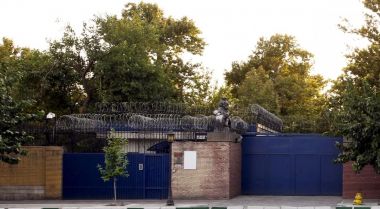Historic move as Britain re-opens Embassy in Iran

Britain reopened its embassy in Tehran on Sunday, a historic step in the thawing of relations between the Islamic state and Western powers, a Reuters witness said.
British Foreign Secretary Philip Hammond declared the embassy open and raised the Union Jack flag in the garden of the nineteenth-century residence in the Iranian capital that was stormed by protesters nearly four years ago.
The move to restore full diplomatic relations marks a thawing of ties with Iran since it reached a nuclear deal with the United States, China, Russia, Germany, France and Britain.
After more than a decade of casting the Islamic Republic as a rogue power seeking to sow turmoil through the Middle East, Britain has sought to improve ties with Iran, whose natural gas reserves are larger even than Russia's.
With the prospect of an end to sanctions, foreign businesses are already jockeying for business in Iran, a nation of 80 million whose economy has withered. Officials have even laid on bus tours for visiting executives looking to refurbish Iran's oil refineries.
While the nuclear deal is seen by its backers as an opportunity for improved relations between Iran and the West, hardliners in Washington and Tehran have opposed it, as has Israel.
Until a new ambassador is announced, the embassy will be led by Ajay Sharma, until now the non-resident chargé d'affaires.
Iranian protesters stormed two British diplomatic compounds in Tehran in November 2011, smashing windows, torching a car and burning the British flag in protest against nuclear-related sanctions imposed by London, long-regarded as the "Old Fox" in Iran for its perceived malign influence in regional affairs.
There had been regular protests outside the British embassy over the years since the 1979 Islamic revolution that toppled the U.S.-backed shah, but none were as violent as the 2011 storming.
At the time, Prime Minister David Cameron called the attacks "outrageous and indefensible" and scolded the Iranian government for failing to defend British staff and protect the imposing building, which had been a treasure trove of valuable paintings and historic memorabilia.
Protesters smashed the large stone lion and unicorn on the gates at the ambassadorial residence, where in 1943 a dinner was held for Winston Churchill, Joseph Stalin and Franklin D. Roosevelt -- the first meeting between the leaders of Britain, Russia and the United States to discuss their strategy for winning World War Two.
Britain responded by shutting Iran's embassy in London and expelling its diplomats. For the last two years, Tehran has been represented by a non-resident charge d'affaires.
Britain, and the United States, have long been viewed with considerable suspicion in Tehran.
There has been no U.S. embassy there since it was sacked in the early days of the Islamic Revolution in 1979 by students who feared a repeat of a 1953 coup when the CIA orchestrated the overthrow of Prime Minister Mohammad Mossadegh.











